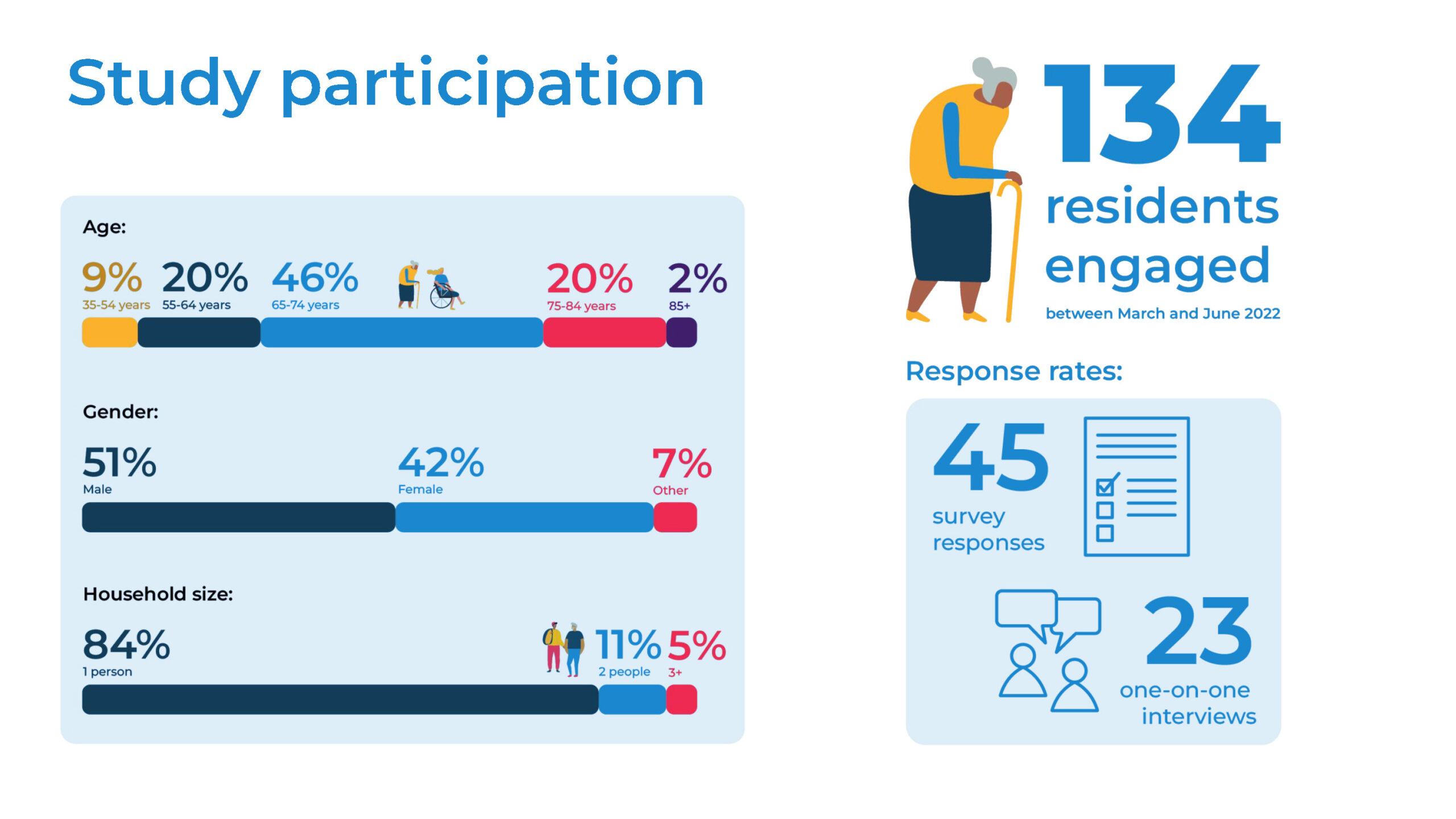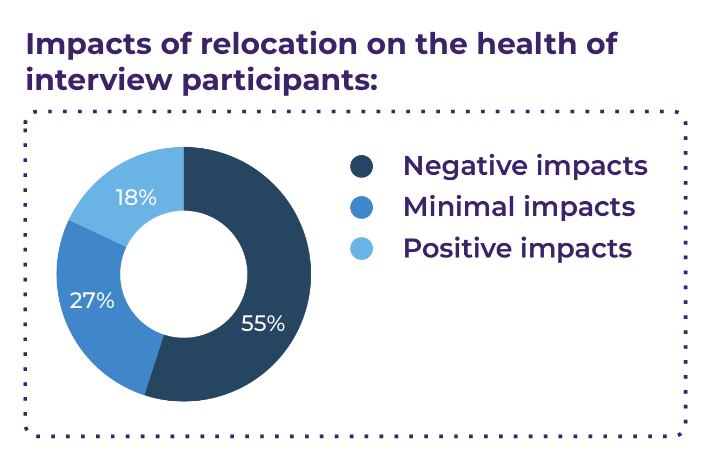Resident Relocation Best Practices: Six Well-being Elements to Consider
June 15, 2023 | Authored for Brightside by Happy Cities
Much of the rental and low-income housing stock in Metro Vancouver is aging and requires significant upgrades or even redevelopment. Many of these buildings can no longer meet the health and well-being needs of their residents.
When buildings need redevelopment or major renovations, residents are often relocated to accommodate upgrades or new development. Due to restrictive zoning and the high cost of land, it is often easier for non-profit housing providers to redevelop and densify existing buildings or sites, rather than acquiring new ones. By improving their existing properties, non-profit housing providers can offer affordable and supportive homes to more people, and better meet the needs of their current residents.
However, redevelopment poses challenges to well-being and affordability. Cities, developers, and housing providers can improve residents’ experience of the relocation process by placing residents’ well-being front and centre—all the way from the first announcement of relocation, to the completion of the new building.
Brightside Community Homes Foundation is currently redeveloping four of its affordable rental housing buildings in Vancouver, and wanted to understand resident satisfaction with its relocation process—including how this process can better support people’s unique well-being needs. To do so, Brightside engaged Happy Cities, a Vancouver-based urban design, research, and engagement firm. Happy Cities engaged directly with Brightside residents who had recently been relocated to understand how moving impacted their well-being, and how the process could be improved going forward.

By centring the experiences of residents themselves, this study offers a roadmap for improving the resident relocation process, outlining concrete actions that housing providers and municipalities can take to support well-being throughout redevelopment. Well-being-focused relocation standards can ensure that our communities grow and densify in a healthy, resilient way.
Context
Many cities have tenant relocation and protection policies, outlining steps that housing providers must follow if they ask tenants to move out for redevelopment. Brightside is committed to going beyond the City of Vancouver’s minimum Tenant Relocation and Protection Policy requirements, and has created a Handbook outlining its resident relocation standards. Brightside also employs internal Resident Relocation staff to help residents through the relocation process by answering questions, helping people find alternative accommodations, and connecting them with other resources as required. Brightside’s policies include strict requirements such as financial compensation, moving support, and the right of first refusal once the new units are complete.
Study overview
Through surveys and interviews conducted from March to June in 2022, Happy Cities engaged directly with 134 residents who had recently relocated to a new building as a result of Brightside’s redevelopment projects. The majority moved to another building operated by Brightside; however, some chose to move to a building operated by another provider. Many of these residents had been long-term tenants of the buildings, with 42 per cent having lived in their building for over 10 years.

Positively, the majority of residents surveyed said they were satisfied with the relocation process offered by Brightside. Those who were unsatisfied also were also likely to indicate that their household expenses and commuting time had increased following relocation—two factors that may contribute to dissatisfaction with the move.

Below, we explore the key well-being findings from this study, highlighting considerations for resident relocation across the housing continuum.
Key well-being findings
No matter who you are, it takes time to adjust to living in a new home. The study measured six key variables that can impact residents’ well-being during relocation and in their new home.
1. Trust
Trust is at the centre of all healthy relationships, and is closely linked to people’s sense of safety. Trusting residents are more willing to engage with one another, participate in activities, and ask for help when they need it. Not only is trust important for the well-being of residents, it benefits landlords, too. People who trust their housing providers and neighbours are more open to communication and resolving conflict.

Trust is at the heart of people’s ability to accept and adapt to a relocation process. For many survey respondents, trust was closely linked to building relationships with staff and neighbours over many years. Therefore, key to building trust—and maintaining it throughout relocation—is open and transparent communication with residents. An effective way that Brightside established communication, support, and trust with residents was through its internal Resident Relocation Coordinators.
“The two relocation staff were wonderful to me,” said one resident. “[They were] very organized, honest, helpful, caring and warm. They did a good job relocating me to my new home. It was a lot of work [to relocate] but Brightside made the process easy for me.”
Housing providers can further build trust by offering choices—such as a range of building options to relocate to, and different choices for help with moving—and involving residents in decisions about their home and their move. Research shows that residents who feel they have input over decisions concerning their home generally trust their community more.
2. Tenure
Tenure is the amount of time someone stays in their home, building, or community. Living in the same place for a long time is closely linked to affordability, as people who have lived in the same unit for many years often pay lower rent than their surrounding neighbours. Long-term tenure also makes it easier for residents to form and maintain greater social bonds and trust with their neighbours and wider community. People who live in the same building or neighbourhood for a long time report higher life satisfaction, increased interpersonal trust, and a strong sense of belonging.
Tenure is particularly important for groups such as seniors or people with various health conditions, who may find a move both physically and emotionally stressful. The majority of Brightside residents in this study had lived in their homes for 10 years or longer, with seniors particularly valuing long-term tenure and the ability to age in place.
“The financial compensation from Brightside to move was huge, given that many of us are seniors on a fixed income,” said one resident. “The move would have been daunting without this financial support.”

While redevelopment requires moving to a new building, it doesn’t have to mean an unfamiliar neighbourhood. Housing providers can help minimize disruptions to long-term tenure by offering housing options to stay in the same neighbourhood, and ensuring that the buildings offered meet people’s long-term needs, so that relocated residents don’t have to move again if they don’t want to.
3. Sense of Belonging
When people feel welcome and at ease in a home, space, or community, it benefits their mental health.
Relocation can interrupt people’s sense of belonging, particularly if they move to a new or unfamiliar neighbourhood where they have fewer social connections and community amenities. In our study, the key factors behind residents feeling a decreased sense of belonging after moving were a lack of relationships with neighbours in their new building, and the sense that it takes many years of living in one place to build a strong sense of belonging. Relationships take time to form, and many relocated residents said they experienced difficulty forming new relationships in their new building.

Two key strategies emerged for supporting people’s sense of belonging through the move. First, residents who relocated together with a group of neighbours were generally more satisfied with the relocation process, reported less mental health impacts, and were more resilient through the transition period. Second, residents who moved to buildings that were within walking distance of neighbourhood amenities, such as community centres, also experienced a greater sense of belonging.
“Social activities at the local community centre have had a really positive impact on my sense of belonging in the new community,” said one resident.
4. Social Connectedness
People with strong social connections live longer, sleep better, and regularly report feeling happier. People benefit from a wide range of social interactions, including both casual encounters in the community and deeper relationships with family and friends. Over time, strong relationships with neighbours can bring benefits including financial savings, trust, and resilience, and even shared childcare, recipes, and meals.
However, around 30 per cent of the Brightside residents surveyed reported decreased social connection post-relocation, demonstrating the need to take extra care to support residents in building new social connections after relocation. A quarter of respondents said they would like to get to know their neighbours better; however, some cited barriers, including a lack of trust, past experience of conflict with neighbours, or health concerns such as COVID-19.
“Past negative experiences have a huge impact on my ability to trust new neighbours,” said one resident. “Sometimes, it’s easier to stay in my own space rather than risk conflict.”
Safe, inclusive social activities and comfortable, shared amenity spaces are therefore crucial to bridging these gaps in trust and connection. Housing providers can help residents organize social activities for their building, which help to build trust and comfort among neighbours. By offering more social spaces and opportunities, housing providers can increase resident satisfaction, ease the relocation process, and harness the well-being benefits of social connection.
“I don’t know many of my neighbours and we don’t get together socially,” said another resident. “It’s hard because there’s no social space in this building to meet people. It would be great to have barbecues and luncheons to get to know my neighbours better.”
5. Perceived Health
Feeling healthy is an essential part of feeling happy. Health encompasses people’s mental and physical condition or state, and is closely linked to the types of homes and neighbourhoods we live in. For example, when people live in homes with views of nature, they are more likely to have positive outlooks on life and feel less stressed. Walkable environments with nearby shops and services are also essential, as people who walk or bike have lower health and obesity risks than those who do not, and report higher psychological well-being. Stress is also a major contributor to poor mental and physical health.
During interviews, just over half of residents reported negative impacts on their health following the relocation process, for reasons such as social isolation, chronic health issues, physical strain from moving, or anxiety in adapting to a new area.
“Trying to adjust to new surroundings and a new location has added anxiety and overall stress, which has impacted my health issues,” said one resident.

Housing providers can take steps to minimize the stress associated with moving for residents, such as through open and transparent communication, offering personalized help with moving, providing options for people to stay within the same neighbourhood, and ensuring that moving doesn’t bring a significant increase in cost of living.
6. Spatial Inclusion
People need safe, comfortable, and equal access to shared building spaces and neighbourhood amenities. Well-maintained, comfortable spaces feel safer, encourage people to spend more time there, and increase social encounters. Further, inclusive shared spaces bridge gaps and build trust between neighbours, facilitating interaction among people of various backgrounds, ages, and household sizes.
Inclusion can be supported both within a building, and in the wider neighbourhood it is located within.
In a residential building, housing providers can activate shared spaces with furniture, cooking facilities, games, or organized activities, for example, to offer something of interest to people of diverse ages, cultural backgrounds, and abilities.
Within the neighbourhood context, residents’ satisfaction was closely tied to minimizing disruptions in their ability to visit neighbours’ homes, libraries, places of worship, health clinics, parks and plazas, community centres, and restaurants or cafés. Relocated residents expressed a strong desire for spaces to spend time outside and socialize with others.
“I love my new community and wouldn’t want to leave,” said one resident who relocated. “I have great access to parks, services, and transit here.”
A Roadmap to Wellbeing-Focused Resident Relocation
Based on feedback from residents and results from the well-being study, Happy Cities developed a Well-being-focused Tenant Relocation Roadmap for Brightside, outlining five key phases of relocation. The Roadmap includes 19 recommendations to support residents’ well-being—each targeted at different phases of the redevelopment process.
As municipalities across the Lower Mainland are looking to strengthen their tenant relocation requirements, the learnings from this study can help inform equity-based relocation policies that centre resident well-being, and support inclusive, resilient communities.
Read more below, or click here to download a PDF version.
For more information about this Study, or about Brightside’s Resident Relocation policies and practices, contact the Brightside Resident Relocation Services team at relocationservices@brightsidehomes.ca.

This work was made possible by funding from the Community Housing Transformation Centre (CHTC) and from Vancity. Without the generous grant contributions from these funders, this Resident Relocation Study would not have been possible.


